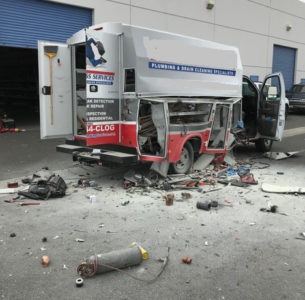
August 28, 2018
A recent service truck explosion reminds us of the dangers of explosive atmospheres. The incident occurred when a local plumbing contractor purchased a new service truck with weather-tight outdoor storage bins. Stored inside one of the bins was a 1-pint container of PVC primer, which, according to the local fire department, released enough vapor to create a hazardous atmosphere. The trapped vapors and an ignition source – the electronic bin lock system – resulted in an explosion. The blast was significant enough to cause major damage to the vehicle and could have resulted in serious or fatal injuries. Fortunately, no one was near the explosion.
Explosive conditions
Several conditions must be met simultaneously for a fire or explosion to occur. Fuel (i.e., combustible gas) and oxygen (i.e., air) must exist in certain concentrations near an ignition source (i.e., spark or flame). The dangerous ratio of fuel and oxygen varies for each combustible gas or vapor, and explosions can occur at any time with disastrous consequences. It’s critical for employers and employees to understand these hazards and implement ways to control them.
Prevention tips
- Store flammable substances in sealed containers to avoid any release of vapors.
- Eliminate sources of ignition when working with flammables. Keep away from heat, sparks, open flames and hot surfaces. Do not smoke!
- Use explosion-proof electrical/ventilating/lighting equipment. Use only non-sparking tools. Take measures to prevent static discharge.
- Read safety data sheets (SDS) for each chemical to understand its characteristics, conditions to avoid, storage practices, incompatibilities and other useful information.
- Avoid working with flammable substances in confined spaces.
- Conduct periodic inspections to ensure proper storage practices are followed.
- Ground/bond container and receiving equipment.
- Ensure areas are well ventilated when using chemicals indoors.
- Know the location of, and how to operate, fire extinguishers.
- Practice evacuation procedures and know the emergency evacuation plan.
- Never rush. Injuries can be prevented when time is taken to do the job safely.
For more information about explosive atmospheres, contact your CompWest loss control consultant. Visit our online toolbox for helpful loss control resources.
Share this resource:
URL coppied to clipboard.
Or send it directly to someone via our email form:
